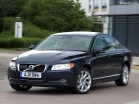Wilvo S80 test drive since 2011 sedan
Volvo S80 AWD
 For the first time, the all-wheel drive boom began back in the 80s of the last century with the advent of all-wheel drive cars on the rally routes. But the four -wheel drive then did not gain particular popularity on ordinary roads, unlike racing tracks. It’s just that at that time there were no reliable, compact and effective structures of all -wheel drive transmission suitable for everyday use on cars. Therefore, almost all manufacturers postponed mass production of all -wheel drive machines until better times.
For the first time, the all-wheel drive boom began back in the 80s of the last century with the advent of all-wheel drive cars on the rally routes. But the four -wheel drive then did not gain particular popularity on ordinary roads, unlike racing tracks. It’s just that at that time there were no reliable, compact and effective structures of all -wheel drive transmission suitable for everyday use on cars. Therefore, almost all manufacturers postponed mass production of all -wheel drive machines until better times. And they came pretty soon. Viskoleti, Torsen differentials, multi -disc councils Haldex, capable of redistribing the torque between the axes and having sufficient speed, high reliability and small sizes. In addition, they were easily controlled. Thus, convenient executive mechanisms were received at the disposal of the designers, and all the work on the proper setting of all -wheel drive was reduced to the creation of competent software, which controls the distribution of torque, depending on the conditions of movement.
 The updated Volvo S80 thanks to new lighting equipment and other strokes began to look more modern. And the appearance of modification with all -wheel drive was a good reason to check how successful the settings offered by Swedish engineers. The S80 AWD transmission uses a multi -disk Haldex with electronic control. In normal movement mode, almost the entire torque is transmitted to the front axle. In the case of slipping the front axle (front wheels, it is enough to overtake the rear to a quarter of turning) the coupling sends up to 70% of the torque to the rear axle. The duration of the coupling is less than 0.1 s, that is, everything happens almost imperceptibly for the driver. In acceleration mode, the system makes sure that the moment on the rear axle is not excessive and the skid does not begin, thereby ensuring the stability of the car position during acceleration. And the role of inter -normal locks is played by the TracS anti -boom system.
The updated Volvo S80 thanks to new lighting equipment and other strokes began to look more modern. And the appearance of modification with all -wheel drive was a good reason to check how successful the settings offered by Swedish engineers. The S80 AWD transmission uses a multi -disk Haldex with electronic control. In normal movement mode, almost the entire torque is transmitted to the front axle. In the case of slipping the front axle (front wheels, it is enough to overtake the rear to a quarter of turning) the coupling sends up to 70% of the torque to the rear axle. The duration of the coupling is less than 0.1 s, that is, everything happens almost imperceptibly for the driver. In acceleration mode, the system makes sure that the moment on the rear axle is not excessive and the skid does not begin, thereby ensuring the stability of the car position during acceleration. And the role of inter -normal locks is played by the TracS anti -boom system. In fact, everything happens exactly as it is written in a press release. Fast and stable acceleration on slippery coating is also a means of active security, because, going to the main road, you can not be afraid that the car will not have time to accelerate by staring in snow porridge, and will be substituted under the main road that is running along the main road. On any coatings, it is enough just to press the gas to
 the car began to accelerate evenly and confidently. As for slippery turns, with a small eruption with speed or traction at the first moment, the demolition of the front axis begins, but the thrust is immediately thrown back, and the handling is restored. If the adhesive properties of the tires were not enough and a lateral sliding began, you need to quickly and smoothly remove the gas so that the wheels are again caught on the road.
the car began to accelerate evenly and confidently. As for slippery turns, with a small eruption with speed or traction at the first moment, the demolition of the front axis begins, but the thrust is immediately thrown back, and the handling is restored. If the adhesive properties of the tires were not enough and a lateral sliding began, you need to quickly and smoothly remove the gas so that the wheels are again caught on the road. By the way, this is exactly what the DSTC stabilization system sets as an option, if necessary, additionally branding one or more wheels. And if you like the rally technique of passing turns, you need to turn off the stabilization system and then do everything as on any normal all -wheel drive car. On the way to the beginning of the arc - the steering wheel in the direction of turning and full gas, and as soon as the car began to rotate, you need to catch it with a steering wheel and gas and then lead a fan in turn, trying to ensure that it was oriented exactly in the direction of movement. Further until the next turn is full of gas. It is not difficult to ride the S80 AWD, because thanks to a long base, the skid does not develop very quickly, however, and the machine stabilizes quite smoothly, so that everything needs to be done, but otherwise we did not find any problems.
 But is it worth it to simulate rally races driving a comfortable business sedan cost of about 50 thousand euros? Isn't it better to buy something cheaper for this and train somewhere in a specially designated safe place for this? And on the Volvo S80 AWD just go on business and on vacation, not particularly experiencing due to the weather or condition of the road. In the end, the all -wheel drive modification of the S80 was created for such purposes and it is better to use it for its intended purpose.
But is it worth it to simulate rally races driving a comfortable business sedan cost of about 50 thousand euros? Isn't it better to buy something cheaper for this and train somewhere in a specially designated safe place for this? And on the Volvo S80 AWD just go on business and on vacation, not particularly experiencing due to the weather or condition of the road. In the end, the all -wheel drive modification of the S80 was created for such purposes and it is better to use it for its intended purpose. Some technical characteristics of Volvo S80 AWD
(manufacturer data)
Dimensions, mm: 4822x1832x1434
Base, mm: 2791
Front/behind, mm: 1570/1548
Diameter of the turn, m: 11.4
Equipped mass, kg: 1584
Trunk volume, l: 460
Engine type: gasoline R5 with turbocharged
Max. Power, L.S./O/min: 200/6000
Max. moment, nm/rpm: 285/1800-5000
Transmission: automatic 5-band
Drive: complete
Tires: 215/55 R16
Max. Speed, km/h: 210
Acceleration time 0-100 km, s: 8.5
Fuel consumption (average), l/100 km: 10.2
Top volume, l: 70
Leonid Klimanovich


Source: Avtopanorama magazine








